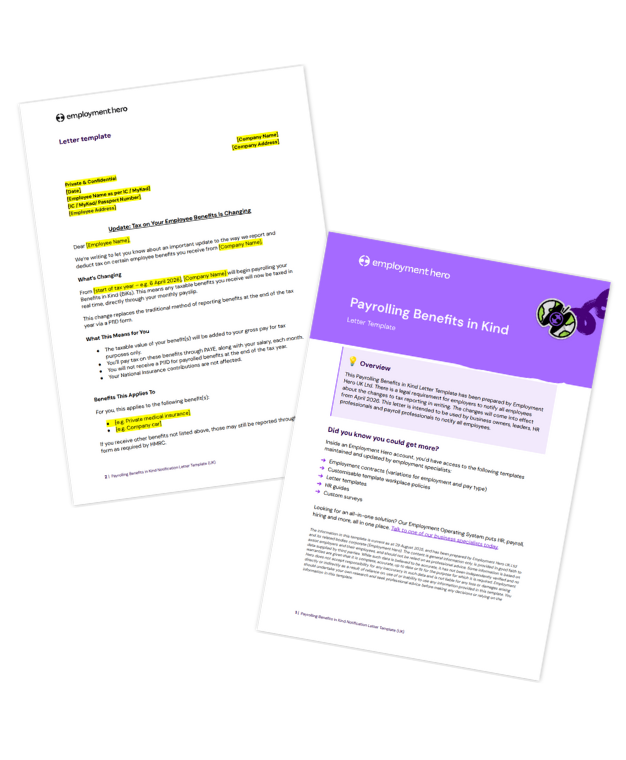Secondment Agreements: What You Need to Know
Published
Secondment Agreements: What You Need to Know
A secondment can be a game-changing move for your business and your people, offering a powerful way to share skills, fill resource gaps and supercharge development. But without a clear framework, this opportunity can quickly become a legal minefield. The key to unlocking its potential isn’t luck; it’s a rock-solid secondment agreement.
This resource cuts through the complexity. We’ll show you how to structure an agreement that protects everyone involved—your employees, your business and the host organisation. This isn’t just about paperwork; it’s about creating total clarity and confidence from day one.
What is a secondment agreement?
Let’s kick things off with the basics. A secondment agreement is a formal, written rulebook that defines the terms of an employee’s temporary move to another organisation or a different part of your business. Its core purpose is to create a clear, triangular relationship between you (the original employer), your employee and the host organisation.
Forget about informal arrangements and handshake deals. A written contract is absolutely essential. It protects the employee’s continuity of service and original employment rights, which is a legal necessity. It also clarifies who is responsible for what, from day-to-day management and pay to handling disputes. This document isn’t just a formality; it’s your first line of defence against misunderstandings and legal challenges, making it a foundational element of your overall HR compliance strategy.
What counts as a secondment?
A secondment agreement is any temporary assignment outside an employee’s usual role, where they are expected to return at the end of the period. They come in two forms:
- Internal: Your employee moves to a different department, team or project within your own company. This is a fantastic tool for employee development, breaking down internal silos and plugging temporary skill gaps with trusted talent.
- External: Your employee is temporarily loaned to a completely separate organisation. This could be a charity, a client, a supplier or another business within a corporate group. It’s a powerful way to strengthen partnerships, share expertise and give employees invaluable external experience.
Whether internal or external, the success of the arrangement hinges on a detailed contract. So, what exactly needs to be in it?
What should a secondment agreement include?
Your secondment agreement must be comprehensive, leaving zero room for ambiguity. A vague contract is just an invitation for future disputes. So here are the non-negotiable clauses you must include:
- Parties involved: Clearly identify the employee, your business (the original employer) and the host organisation.
- Duration: Specify the exact start and end dates. Include provisions for extending or for terminating early.
- The role: Detail the job title, duties and key responsibilities at the host organisation.
- Pay and benefits: Outline the salary, who pays it and how benefits like pensions, bonuses and health insurance will be managed. Confirm who will be liable for any income tax and national insurance contributions.
- Line management: Define who handles day-to-day supervision (usually the host) versus who handles formal HR matters like discipline and grievances (the original employer).
- Confidentiality: Include clauses to protect the sensitive information of all three parties.
- Return-to-work guarantee: Clearly state that the employee has the right to return to their substantive role (or a similar one) at the end of the contract. This is critical for protecting their employment rights.
Who is responsible for paying the employee during a secondment?
Typically, you, the original employer, remain responsible for paying the employee’s salary and managing their benefits. This is crucial for maintaining their continuity of employment and ensuring their rights are protected.
In an external secondment agreement, the host organisation usually reimburses you for these costs. The specifics of this financial arrangement should be detailed in a separate commercial agreement between your two organisations. Your secondment agreement with the employee simply needs to confirm who will be processing their pay. Getting this right is a key part of maintaining spotless payroll compliance.
Of course, a secondment isn’t always smooth sailing. What happens if performance issues arise?
Can an employee be disciplined or dismissed while on secondment?
Yes, but you must handle the process with care. As the original employer, you almost always retain ultimate authority over the employment relationship.
While the host manager will handle day-to-day performance feedback, any formal disciplinary or grievance procedures must be escalated back to you. The host should report any issues, but you are responsible for conducting a fair investigation and following your established procedures. Attempting to dismiss an employee without following a proper process is a fast track to an unfair dismissal claim.
Just as with discipline, the tricky subject of redundancy also needs to be handled correctly.
Can an employee be made redundant while on secondment?
An employee on a secondment agreement is not shielded from redundancy. If their original role at your organisation is at risk, they must be included in the consultation process just like any other employee.
You have a legal duty to consult meaningfully with your seconded employee, inform them of the situation and explore any suitable alternative employment. Singling them out or forgetting about them because they are “out of sight, out of mind” is a direct route to a costly and damaging employment tribunal claim.
Beyond these major events, you also need to clarify the day-to-day arrangements for time off.
Impact of secondment on holiday and sick leave
Your employee’s statutory entitlements to holiday and sick pay continue completely uninterrupted. The contract must clarify the practical arrangements to avoid confusion:
- Holiday leave: Who authorises holiday requests? Who tracks the employee’s leave entitlement? Usually, the employee will follow the host’s procedures for booking time off, but your policy on entitlement will still apply.
- Sick leave: Who should the employee notify if they are unwell? Typically, they should inform both their host manager and you. Sick pay will be handled by you, according to the terms of their employment contract.
Having clear processes in place is vital, especially when things don’t go as planned.
What happens if a dispute arises during the secondment?
Disputes can happen, but a good contract sets out a clear path for resolution. It should specify who the employee should raise a grievance with—which is almost always you, their original employer.
Your process should detail how you will coordinate with the host to investigate the issue fairly. Clear communication channels between all three parties are vital to resolving conflicts before they escalate. For complex situations, seeking professional HR advisory services can provide critical guidance and peace of mind.
This brings us back to a fundamental question: what happens to an employee’s rights during this temporary move?
Do seconded employees keep their employment rights?
Absolutely. This is one of the most critical functions of a secondment agreement. The entire arrangement is structured to ensure your employee’s continuity of service is preserved without any breaks.
This means their start date for calculating statutory rights (like redundancy pay or unfair dismissal eligibility) remains their original hire date. They retain all their contractual rights and protections under UK employment law. The secondment is simply a temporary change in duties and location, not a termination and re-hire.
This temporary nature raises another key question: how long should it last?
How long can a secondment last?
There’s no legal maximum or minimum, but secondment agreements are by nature temporary. They typically last anywhere from six months to two years.
It’s essential to include a specific end date in the contract. If the arrangement is a roaring success and everyone agrees, it can be extended. However, if a secondment continues indefinitely, you risk it being legally viewed as a permanent change, which could unintentionally transfer employment to the host. A clause allowing for renewal by mutual agreement gives you valuable flexibility without the legal risk.
Flexibility works both ways, so you also need a plan for ending things early if necessary.
Can a secondment agreement be terminated early?
Yes, but only under circumstances outlined in the contract. It should include a notice clause that specifies how much notice any of the three parties must give to end the arrangement ahead of schedule.
Common reasons for early termination include:
- The project finishing early
- Poor performance
- Significant business changes at either your organisation or the host’s.
A clear termination clause prevents one party from being left in a difficult position and ensures a professional exit for everyone.
Is a secondment agreement legally binding?
Once signed by the employee, the original employer and the host organisation, it becomes a legally enforceable contract. It creates clear rights and obligations for everyone involved.
This is precisely why a written contract is so vital. It replaces verbal promises and vague assumptions with clear, documented terms. Should a dispute arise, this document will be the primary evidence used to determine each party’s responsibilities. It’s an indispensable part of your HR compliance bundle.
Download the checklist
A well-executed secondment agreement is a powerful strategic tool. It drives employee growth, strengthens business relationships and brings fresh energy into your organisation. With a clear and comprehensive secondment agreement, you can eliminate legal risks and ensure the experience is positive and productive for everyone.
To help you get it right every time, we’ve created a detailed checklist. It covers every stage of the process, from drafting the contract to managing your employee’s triumphant return. Stop guessing and start leading.
Register for the checklist
Related Resources
-
 Read more: Payrolling Benefits in Kind (BIKs): Employer Obligations (+ Notification Letter Template)
Read more: Payrolling Benefits in Kind (BIKs): Employer Obligations (+ Notification Letter Template)Payrolling Benefits in Kind (BIKs): Employer Obligations (+ Notification Letter Template)
Stay up-to-date with upcoming rules on benefits in kind (BIKs) payrolling. Learn what’s mandatory from 2026, current obligations & download…
-
 Read more: A Business Owners Guide to Adopting AI
Read more: A Business Owners Guide to Adopting AIA Business Owners Guide to Adopting AI
Discover how to successfully navigate AI adoption in your business. This guide covers key steps, benefits, risks and real-world tips…
-
 Read more: Work-Related Social Events Policy Template
Read more: Work-Related Social Events Policy TemplateWork-Related Social Events Policy Template
Ensure your staff social events run smoothly with our workplace social events policy template. Customisable and easy to use.



















